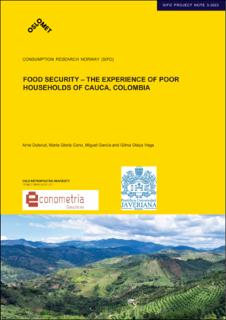| dc.description.abstract | Background: Food insecurity refers to a lack of access to guarantee enough food in terms of quantity, quality, use and stability. There are different causes of food insecurity, and the household food insecurity is one of the main causes of malnutrition in vulnerable populations.
Object: To study food security in households in terms of food availability and food access in four municipalities in the department of Cauca, Colombia.
Methodology: A multicenter cross-sectional study was conducted in four municipalities in Cauca, Colombia, to explore food security in post-conflict rural and urban municipalities using three indicators: Food Consumption Score (FCS), Household Dietary Diversity (HDDS) and The Food Insecurity Experience Scale (FIES).
Results: 69.4% of the selected households were classified as monetary poor. The number of mealtimes on the day before the survey was 2.9 and 22.5% of the households had mealtimes less than three mealtimes/day. Variety of food groups consumed in the meals was poor with no more than three. Food insecurity was experienced by overall 65.7% of the households, which became worse because of Covid-19. The main drivers of food insecurity (FIES) were living in urban zones, low education level of the head of the household, low income, informal or nonpermanent employment and poor kitchen facilities. On the other hand, the main drivers for having a higher number of daily meals were income- related variables (like persons receiving income or having formal or permanent jobs), receiving subsidies, and characteristics related to the education level of the head of the household. Household food provisions depend mainly on access to markets. 53.9% of the households purchase their food in the public marketplace, 27.4% in the supermarket, while own food production was reported in 11.4% of the households.
Conclusion: Food insecurity is highly prevalent among households in both rural and urban areas in Cauca, Colombia, and is accompanied with limited access to food and poor variety of the diet. The main drivers were living in urban zones, ethnicity, vulnerabilities among household members, and not having permanent income sources and/or subsidies. | en_US |
